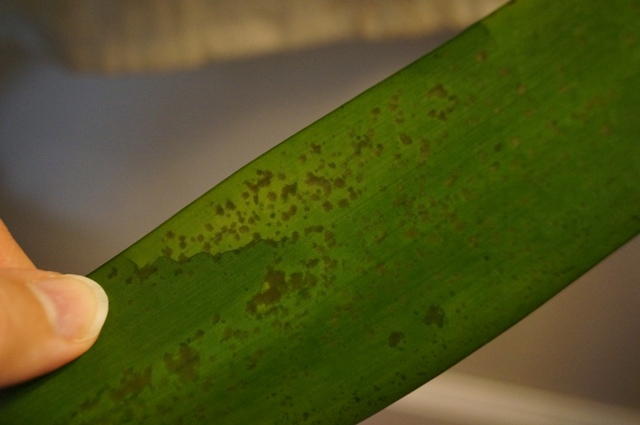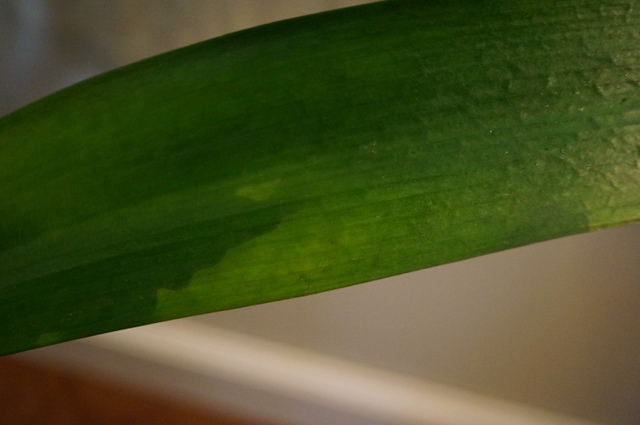Question
 Clivia Leaf Underside
Clivia Leaf Underside  Clivia Leaf Topside
Clivia Leaf Topside
Hi,
Recently (about 2 months ago) my Grandmother gave me a Clivia plant, propagated from her own Clivia... so it's a valuable plant to me. I left it on the porch over the summer, and brought it in when the weather turned cold.
I had gotten another plant from her at the same time (a swiss cheese plant) and I saw that it was infected with what I thought was spider mites. The Clivia had a bit of faint webbing too, So I took them both outside outside and sprayed them down good, and made sure I sprayed off the top layer of soil, then I set them on the porch and sprayed it with a mixture of dish soap, water, oil, and a few drops of alcohol for three days.
I brought them inside, and the Swiss Cheese Plant is looking OK, but I just noticed that on my Clivia, some of the leaves are turning yellow, so I looked at the underside of the plant and it looked like it had been attacked by some kind of bug. Little brownish spots covered the underside of the leaf in spots, and it is killing the leaves and making them turn yellow. I cut off the worst leaves, but there are others that have touches of it.
Is it possible that I damaged it by spraying it with the dish soap solution?
What exactly is this? What can I do about it? I hate to cut off any more leaves, because it is a beautifully balanced Clivia! I thought I would ask here before I did anything else drastic.
Thank you,
Susanna
P.S. Attached is a picture of the spots.
AnswerHi Susanna,
The photos are not real clear so there are several possible causes of the leaf spots and die-back.
If the brown spots are slightly raised and wipe of when you rub them firmly, then they are scale insects. If so, then the entire plant needs to be sprayed until all leaves are dripping wet with a solution of 5 parts water, 1 part alcohol and a squirt of liquid soap. It is essential that you get complete coverage especially in the crevices where the leaves emerge from the main stem.
Your previous spraying may also have damaged the leaves if the wet leaves were exposed to direct sunlight or temperatures below 55 degrees. It is best to spray plants indoors or outside in shade when temps are warm.
You didn't mention how cold it got before you moved your Clivia indoors, so it may be reacting to cold exposure.
It may be reacting to its change in environment from outside where the light is much more intense to inside where light is much dimmer.
Finally, starting in the fall and going through most of the winter, it is important to keep your Clivia very dry if you want it to flower. Over watering at this time of year will cause leaf discoloration.
As you read through these possible causes, I hope you will be able to determine which makes the most sense to you based on your Clivia's environment and that you can take appropriate remedial action.
Please let me know if any of this is unclear or if you have any additional questions.
If this information has been helpful, please click the Rate Volunteer bar below and enter a rating and nomination for me. I am a volunteer on this site so Ratings are the only compensation I receive for answering plant questions.
Need more information? Visit my website at:
A link to HorticulturalHelp.com
or email me at
[email protected] or call me at 917-887-8601 (EST)
Regards,
Will Creed, Interior Landscaper
Horticultural Help, NYC
Visit my website at: A link to HorticulturalHelp.com







